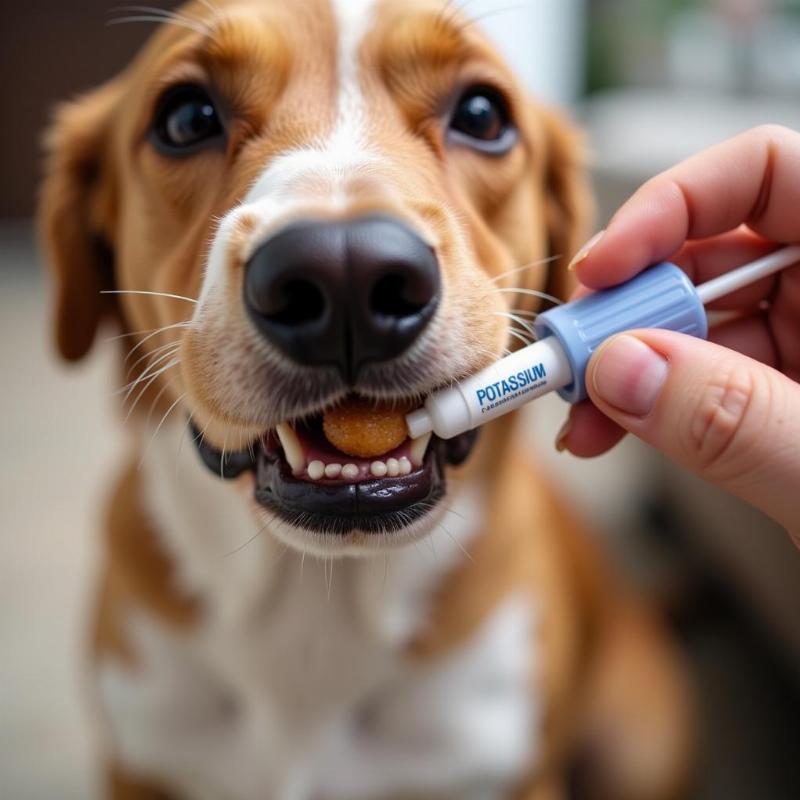Potassium bromide (KBr) is sometimes prescribed by veterinarians to manage seizures in dogs. Understanding the correct potassium bromide dosage for dogs is crucial for its effectiveness and your dog’s safety. This article provides essential information about KBr dosage, administration, potential side effects, and important considerations for dog owners in the United States.
Understanding Potassium Bromide for Canine Seizures
KBr works by increasing the inhibitory neurotransmitter GABA in the brain, thus reducing neuronal excitability and the likelihood of seizures. It’s often used in conjunction with other anti-seizure medications, particularly when seizures are difficult to control. While KBr can be a valuable tool, it’s vital to work closely with your veterinarian to determine the appropriate dosage and monitor your dog for potential side effects.
Determining the Right Potassium Bromide Dosage for Your Dog
The correct potassium bromide dosage for your dog will be determined by your veterinarian based on several factors, including your dog’s weight, breed, the severity of their seizures, and their overall health. There is no one-size-fits-all dosage. Typically, a loading dose is given initially to achieve therapeutic levels in the bloodstream quickly. This is followed by a lower maintenance dose.
Loading Dose vs. Maintenance Dose
- Loading Dose: A higher initial dose to quickly reach therapeutic blood levels. This might involve several divided doses over a few days.
- Maintenance Dose: A lower, regular dose given once or twice daily to maintain the therapeutic levels long-term.
Your veterinarian will perform regular blood tests to monitor bromide levels and adjust the dosage as needed. It’s important to never adjust the dosage yourself without consulting your veterinarian.
 Administering Potassium Bromide to a Dog
Administering Potassium Bromide to a Dog
Administering Potassium Bromide to Your Dog
KBr is typically available as a powder or liquid and is usually mixed with food. It’s essential to mix it thoroughly to ensure your dog ingests the full dose. Some dogs might be sensitive to the taste, so finding a palatable food combination is crucial for consistent administration. Never administer KBr in a dry form as it can cause severe gastrointestinal irritation.
Potential Side Effects of Potassium Bromide in Dogs
While generally safe, KBr can cause some side effects, including:
- Sedation: This is a common initial side effect that often resolves as the dog adjusts to the medication.
- Increased Thirst and Urination: Monitor your dog’s water intake and ensure they have access to fresh water at all times.
- Increased Appetite: Some dogs experience increased hunger while on KBr. Maintain a healthy diet and monitor their weight.
- Coordination Problems (Ataxia): This side effect is more likely with higher doses. Contact your veterinarian if you observe any balance issues.
- Pancreatitis (Rare): A serious but rare side effect. Seek immediate veterinary attention if your dog shows signs of abdominal pain, vomiting, or lethargy.
Important Considerations for Using Potassium Bromide
- Regular Veterinary Checkups: Regular blood tests are essential to monitor bromide levels and adjust the dosage as needed.
- Diet: Sodium intake can affect bromide levels. Your veterinarian might recommend a low-sodium diet.
- Interactions with Other Medications: Inform your veterinarian about all other medications your dog is taking, as KBr can interact with some drugs.
- Pregnancy and Lactation: KBr is not recommended for pregnant or lactating dogs.
Conclusion
Potassium bromide can be an effective medication for managing seizures in dogs. However, careful dosage management and monitoring are crucial for its safe and effective use. By working closely with your veterinarian and following their guidance, you can help your dog experience a better quality of life. Remember to always consult with your vet before making any changes to your dog’s medication.
FAQ
-
How long does it take for potassium bromide to start working in dogs? It can take several weeks, sometimes up to three months, to reach therapeutic levels and see the full effects of KBr.
-
Can I stop giving my dog potassium bromide suddenly? No, abruptly stopping KBr can lead to a resurgence of seizures. Always consult with your veterinarian before making any changes to your dog’s medication.
-
What should I do if my dog misses a dose of potassium bromide? Give the missed dose as soon as you remember. If it’s close to the next scheduled dose, skip the missed dose and continue with the regular schedule. Do not double the dose.
-
Is potassium bromide safe for all dog breeds? While generally safe, certain breeds might be more sensitive to its side effects. Discuss any breed-specific concerns with your veterinarian.
-
Are there any natural alternatives to potassium bromide for dog seizures? While some natural remedies are touted for seizure control, it’s essential to consult with your veterinarian before using any alternative treatments.
Beautdogs.us: Your Trusted Source for Dog Care
Beautdogs.us is a leading online resource for comprehensive and engaging information on dog care, breeds, and lifestyle in the US. We offer expert advice, product reviews, and valuable insights to help you provide the best possible care for your furry companion. Whether you’re a new dog owner or a seasoned enthusiast, Beautdogs.us is your trusted source for all things dog-related. Contact us today for expert advice! Email: [email protected], Phone: +1 501-555-7529.